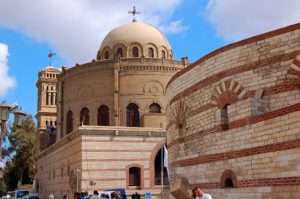
Babylon Fortress and Church of St. George (Photo by Don Knebel)
In the sixth century B.C., the Persians, then in control of Egypt, erected a fortress just east of the Nile River near where an ancient canal led to the Red Sea. The fortress marked the dividing line between Lower (northern) and Middle Egypt, where boats on the Nile River paid tolls for transferring from one region to the other. A town developed around the fortress, called “Babylon” for reasons that are not entirely clear. When the Romans gained control of the area in about 30 B.C., they recognized the strategic importance of Babylon and built an expansive brick and stone fortress near the river, featuring multiple bastions around the perimeter. The fortress was connected to the Nile by a draw bridge supported between two circular towers, each 108 feet in diameter. Babylon was later associated with the journey of Mary, Joseph and the baby Jesus to Egypt to escape King Herod and became the seat of a Christian bishop.
In 640 A.D., Christian defenders of the Babylon Fortress held out for six months before being captured by Muslim invaders. After the Muslims gained control of Egypt, they allowed Christians to build churches within the fortress walls. The famous “Hanging Church,” built in the seventh century, is suspended between the south gate towers of the fortress. The circular Church of St. George was built in the tenth century over the foundation of the northern bridge tower. Six other churches, a convent, and the Coptic Museum are all now located within the perimeter of the former fortress, designated “Coptic Cairo” for the Egyptian Christians who still worship in this area.
Comments are closed.